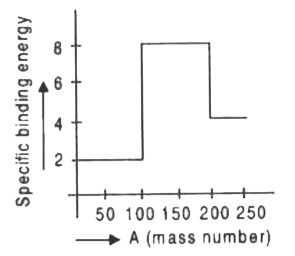Assume that the nuclear binding energy per uncleon (B/A) versus mass number (A) is as shwon in Fig. Use this plot to choose the correct choice (s) given below:
 Solution in Gujrati
Solution in Gujrati
Fusion of two nuclei with mass numbers lying in the range of 1<A<50 will release energy
Fusion of two nuclei with mass numbers lying in the range of 51<A<100 will release energy
Fission of a nucleus lying in the the mass range of 100<A<200 will release energy when broken into two equal fragments
Fission of a nucleus lying in the mass range of 200<A<260 will release energy when broken into two equal fragments
The correct Answer is:B, D
(A) for 1<A<50, on fusion mass number for compound nucleus is less than 100
⇒ Binding energy nucleon remains same
⇒ No energy is released
(B) For 51<A<100 on fusion mass number for compound nucleus is between 100 & 200
⇒ binding energy per nucleon increases
⇒ Energy is released.
(C) For 100<A<200, on fission, the mass number of product nuclei will be between 50 & 100
⇒ Binding energy per nucleon decreases
⇒ No energy is released
(D) For 200<A<260, on fission, the mass number of product nuclei will be between 100 & 130
⇒ Binding energy per nucleon increases
⇒ Energy is released.
Topper's Solved these Questions
- SIMPLE HARMONIC MOTIONBOOK - ALLEN CHAPTER - SIMPLE HARMONIC MOTIONEXERCISE - Match The Column
9 Videos
- SIMPLE HARMONIC MOTIONBOOK - ALLEN CHAPTER - SIMPLE HARMONIC MOTIONEXERCISE - Comprehension #1
3 Videos
- SIMPLE HARMONIC MOTIONBOOK - ALLEN CHAPTER - SIMPLE HARMONIC MOTIONEXERCISE - Exercise-05(B)
46 Videos
- RACEBOOK - ALLEN CHAPTER - RACEEXERCISE - Basic Maths (Wave Motion & Dopplers Effect) (Stationary waves & doppler effect, beats)
25 Videos
- TEST PAPERBOOK - ALLEN CHAPTER - TEST PAPEREXERCISE - PHYSICS
4 Videos
Similar Questions
In y=Asinωt+Asin(ωt+2π3)
∣∣ ∣ ∣ ∣ ∣ ∣ ∣ ∣ ∣∣Column-IColumn-II(A)Motion(p)is periodic but no SHM(B)Amplitude(q)is SHM(C)Initial phase(r)A(D)Maximum velocity(s)π/3(t)ωA/2(u)None∣∣ ∣ ∣ ∣ ∣ ∣ ∣ ∣ ∣∣
View SolutionIn a mixture of H−He+ gas (He+is singly ionized He atom), H atom and He+ ions are excited to their respective first excited state. Subsequently H atoms transfer their total excitation energy to He+ ions (by collisions) Assume that the bohr model of atom is exactly valid.
The quantum number n of the state finally populated in He+ inos is -
View SolutionX- rays are produced in an X- rays tube operating at a given accelerating voltage . The wavelength of the continuous X- rays has values from
View SolutionThe frequency of a radar is 780 MHz. After getting reflected from an approaching aeroplane, the apparent frequency is more than the actual frequency by 2.6 kHz. The aeroplane has a speed of
View SolutionChoose the correct statement:
View SolutionAssume that the nucles binding energy per nucleus(B/A) versus mass number (A) is as shown in the figure Use this plate to choose the energy the correct (s) given below

View SolutionAssume that the nuclear binding energy per nucleon (B//A) versus mass number (A) is as shown in figure. Use this plot to choose the correct choice(s) given below. (a) Fusion of two nuclei with mass numbers, lying in the range of 1ltAlt50 will release energy. Fusion of two nuclei with mass numbers lying in the range of 51ltAlt100 will release energy. (c) Fission of a nucleus lying in the mass range of 100ltAlt200 will release energy when broken into two equal fragements. (d) Fission of a nucleus lying in the mass range of 200ltAlt260 will release energy when broken into two equal fragments.
View SolutionCalculate in the atomic mass units the mass of (a) a Li^(8) atom whose nucleus has the binding energy 41.3MeV , (b) a C^(10) nucleus whose binding energy per uncleon is equal to 6.04 MeV .
View SolutionAssume that the nuclear binding energy per uncleon (B/A) versus mass number (A) is as shwon in Fig. Use this plot to choose the correct choice (s) given below:

View SolutionBinding energy per nucleon plot against the mass number for stable nuclei is show in the figure. Which curve is correct ?
View SolutionAssume that the nuclear binding energy per nucleon (B/A) versus mass number (A) is as shown in the figure. Use this plot to choose the correct choice(s) given below. Figure
View SolutionVARIATION OF BINDING ENERGY OF PER NUCLEON WITH MASS NUMBER
View SolutionExplain the process of nuclear fission and nuclear fussion by using the plot of binding energy per nucleon (BE/A) versus the mass number A .
View SolutionAssume that the nuclear binding energy per nucleon (BIA) versus mass number (A) is as shown in the figure. Use this plot to choose the correct choice(s) given below:
View SolutionAssume the graph of sepecific binding energy versus mass number is as shown in the figure. Using this graph, select the correct choice from the following.

View SolutionAssume the graph of specific binding energy versus mass number is as shown in the figure. Using this graph, select the correct choice from the following :
View Solution
